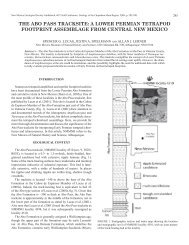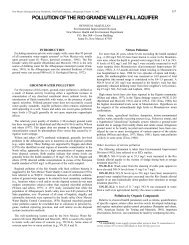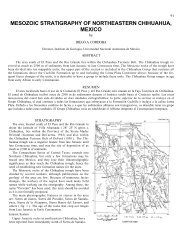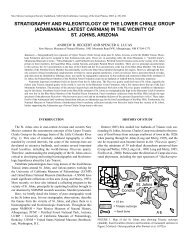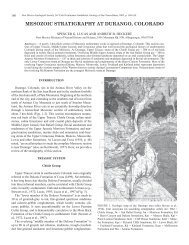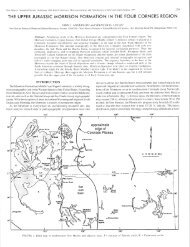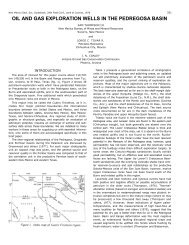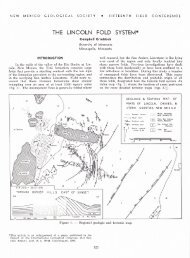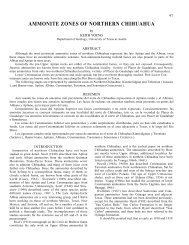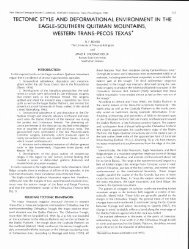When batholiths exploded: The Mogollon-Datil volcanic field
When batholiths exploded: The Mogollon-Datil volcanic field
When batholiths exploded: The Mogollon-Datil volcanic field
Create successful ePaper yourself
Turn your PDF publications into a flip-book with our unique Google optimized e-Paper software.
WHEN BATHOLITHS EXPLODE<br />
as too viscous to flow over more than short distances and one of<br />
them dismissed pyroclastic rocks with a footnote: “… the number<br />
of tuffs sent to petrographers for microscopic examination is out<br />
of all proportion to their abundance in the <strong>field</strong>” (Grout, 1932, p.<br />
117). <strong>The</strong> leading European textbook proclaimed: “rhyolite does<br />
not have wide distribution” (“Der Rhyolith hat keine grosse Verbreitung;”<br />
Barth et al, 1960).<br />
Authority Questioned: Mysterious Rhyolite<br />
Sheets of Silver City<br />
Authority had long been contradicted in the Silver City quadrangle,<br />
where Paige (1916) had identified columnarly jointed<br />
sheets as rhyolite lava flows. Beginning in 1950, mapping in<br />
adjoining areas (minipaper; Day 2, Stop 5, this volume) found<br />
that some of these sheets, from a few meters to cumulatively<br />
>100 m thick, had flowed for >100 km. <strong>The</strong> solution to the viscosity<br />
problem was offered by Pat Callaghan, who had seen similar<br />
rocks in the Great Basin: these rocks were not lava flows but<br />
welded tuffs, i.e., inflated hot pyroclastic flows of minimal viscosity,<br />
in which a matrix of incandescent glass shards had welded<br />
into hard rock. However, the degree of welding can vary, even<br />
within a single flow. As not all pyroclastic flows (also called ash<br />
flows; Smith, 1960) are welded, ignimbrite (Marshall, 1935) or<br />
ash-flow tuff (Ross and Smith, 1961) have replaced welded tuff.<br />
<strong>The</strong> <strong>volcanic</strong> province of Figure 1 was the site of a mid-Cenozoic<br />
ignimbrite flareup (term used by P. J. Coney in a letter to W. E.<br />
Elston, dated December 16, 1976; does any reader know of an<br />
earlier use in print?). It is now known that similar events have<br />
occurred on all continents, in all Phanerozoic geologic periods,<br />
and to even greater extents in the Precambrian.<br />
Recognition of pyroclastic transport left unanswered the question<br />
of where and how the rhyolite sheets had erupted. Textbooks<br />
taught that small-volume rhyolite flows came from lava domes,<br />
but where did rhyolite sheets come from? Were they fed by hidden<br />
bodies of granite magma? Did not leading Authorities question<br />
the very existence of voluminous granite magma?<br />
CONTROVERSY: IS GRANITE MAGMATIC<br />
OR METASOMATIC?<br />
Confrontation: the Great Debate of 1947<br />
From the 1930s into the 1960s, a fierce debate raged over the<br />
magmatic vs. metasomatic origin of granite. Granite is fundamental<br />
to continental basements and cores of continental mountain<br />
ranges. In our solar system, only planet Earth has well-defined<br />
continents and ocean basins. Basalt is the universal in rocky planets,<br />
but voluminous granite is diagnostic of Earth.<br />
<strong>The</strong> climactic confrontation came at a symposium during the<br />
annual meeting of the Geological Society of America at Ottawa<br />
in 1947. <strong>The</strong> chief protagonists were H. H. Read (Royal School of<br />
Mines, London) on the side of those who held most granites to be<br />
transformed sedimentary rocks, and N. L. Bowen (Geophysical<br />
Laboratory, Washington), on the side of the magmatists. <strong>The</strong>ir<br />
backgrounds illustrate two different approaches to geology: <strong>field</strong><br />
119<br />
work (“<strong>The</strong> best geologist is he who has seen the most rocks;”<br />
Read, 1940) and the experimental observation of rocks “in process<br />
of formation” (Bowen, 1948, p. 80). Among advanced thinkers<br />
of that day, Bowen, father of the reaction series, was regarded<br />
as a reactionary<br />
Read: <strong>The</strong> Case for Metasomatism<br />
In the Ottawa symposium, Read (1948) conceded that there<br />
were granites and granites (the title of his presentation) but stated<br />
that he could not follow “the vertical leap from rhyolite to granite”<br />
(p. 3). While meditating upon granite in a WWII air-raid shelter,<br />
Read (1943-44) had cited Daly (1914) to conclude that rhyolites<br />
were insignificant and unrelated to most granites. Following<br />
Kennedy (1938), he restricted the term igneous to <strong>volcanic</strong> rocks,<br />
overwhelmingly basalt and andesite. Granite and related rocks<br />
belonged to a plutonic class, with metamorphic rocks and migmatites,<br />
i.e., mixed granitic and metasedimentary rocks.<br />
<strong>The</strong> term migma or ichor was originally used to describe a<br />
granitic residual magma, highly enriched in fluids. It produced<br />
migmatites by soaking into metasedimentary rocks (Sederholm,<br />
1933). In the hands of Wegmann (1935), it became a vaguely<br />
defined fluid that could turn sedimentary rocks into metasomatic<br />
granite by migration (Stoffwanderung). Read (1948) identified<br />
metasomatic granite by its basic front (Reynolds, 1947), a ferromagnesian<br />
aureole flushed from sedimentary rocks during<br />
granitization. Perrin and Roubault (1939) dispensed with fluids<br />
altogether. In their view, the ichor consisted of ions diffusing in<br />
the solid state.<br />
Bowen Strikes Back: Granite and Rhyolite are Comagmatic<br />
Bowen (1948) minced no words, beginning with the title of<br />
his presentation: <strong>The</strong> granite problem and the method of multiple<br />
working prejudices. He found large-scale solid-state diffusion to<br />
be contrary to the laws of physics, and ichor to be a substance<br />
which always did exactly what its proponents wanted it to do.<br />
Not finding any evidence for a basic front around great Mesozoic<br />
<strong>batholiths</strong> of western North America, he called “that corollary<br />
of wet granitization…a basic affront to the intelligence of<br />
the geologic fraternity” (p. 88). In Bowen’s (1948, p. 86) “at<br />
the moment not very respectable” opinion, “most …granitic rock<br />
…was formed by crystallization of an intrusive molten magma<br />
closely resembling… rhyolitic lavas.” Such magma could be<br />
formed in several ways, but “…most granites have been produced<br />
throughout geologic time by differentiation of basic (basaltic)<br />
magma….” (p. 87).<br />
A year earlier, Bowen had contrasted petrologists who pontificated<br />
from solid experimental evidence with those who transformed<br />
rocks by soaking them with ichors, calling them “pontiffs<br />
and soaks…the soak must have his liquor in lavish quantities, but<br />
the former handles his liquor like a gentleman” (Bowen, 1947, p.<br />
264). To which Read (1948, p. 1) cheerfully responded: “…pontiffs,<br />
I suggest to Professor Bowen, while capable of a greater<br />
number of good deeds, are also capable of a greater number of<br />
bad deeds than the village drunk.”




